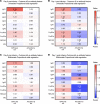Understanding the treatment benefit of hyperimmune anti-influenza intravenous immunoglobulin (Flu-IVIG) for severe human influenza
- PMID: 37289541
- PMCID: PMC10443807
- DOI: 10.1172/jci.insight.167464
Understanding the treatment benefit of hyperimmune anti-influenza intravenous immunoglobulin (Flu-IVIG) for severe human influenza
Abstract
BACKGROUNDAntibody-based therapies for respiratory viruses are of increasing importance. The INSIGHT 006 trial administered anti-influenza hyperimmune intravenous immunoglobulin (Flu-IVIG) to patients hospitalized with influenza. Flu-IVIG treatment improved outcomes in patients with influenza B but showed no benefit for influenza A.METHODSTo probe potential mechanisms of Flu-IVIG utility, sera collected from patients hospitalized with influenza A or B viruses (IAV or IBV) were analyzed for antibody isotype/subclass and Fcγ receptor (FcγR) binding by ELISA, bead-based multiplex, and NK cell activation assays.RESULTSInfluenza-specific FcγR-binding antibodies were elevated in Flu-IVIG-infused IBV- and IAV-infected patients. In IBV-infected participants (n = 62), increased IgG3 and FcγR binding were associated with more favorable outcomes. Flu-IVIG therapy also improved the odds of a more favorable outcome in patients with low levels of anti-IBV Fc-functional antibody. Higher FcγR-binding antibody was associated with less favorable outcomes in IAV-infected patients (n = 50), and Flu-IVIG worsened the odds of a favorable outcome in participants with low levels of anti-IAV Fc-functional antibody.CONCLUSIONThese detailed serological analyses provide insights into antibody features and mechanisms required for a successful humoral response against influenza, suggesting that IBV-specific, but not IAV-specific, antibodies with Fc-mediated functions may assist in improving influenza outcome. This work will inform development of improved influenza immunotherapies.TRIAL REGISTRATIONClinicalTrials.gov NCT02287467.FUNDINGFunding for this research was provided by subcontract 13XS134 under Leidos Biomedical Research Prime Contract HHSN261200800001E and HHSN261201500003I, NCI/NIAID.
Keywords: Adaptive immunity; Immunology; Infectious disease; Influenza; NK cells.
Conflict of interest statement
Figures









